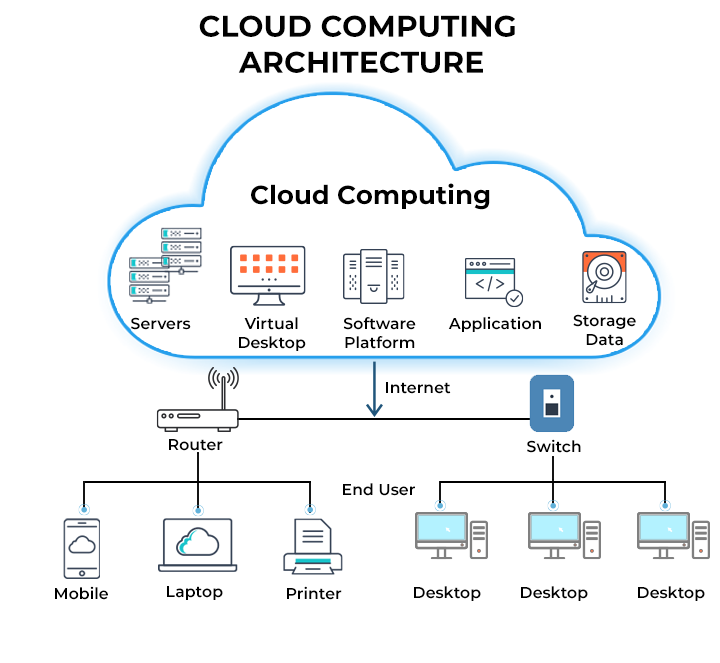In the modern technological landscape, the paradigm shift towards accessing IT resources over the internet has become ubiquitous. This model, known as cloud computing, has fundamentally changed how businesses and individuals acquire, manage, and utilize technology. At the heart of this transformation are the offerings themselves, the distinct capabilities and resources delivered on demand, which are collectively known as cloud computing services. These services are the tangible components of the cloud, providing everything from raw computing power and vast storage capacity to sophisticated software applications and cutting-edge machine learning tools, all without the need for users to own or maintain the underlying physical infrastructure. Understanding the different types of cloud services available, what each model entails, and the specific benefits of cloud services they provide is essential for organizations looking to harness the power of the cloud effectively. The spectrum of cloud computing services is broad and continually expanding, encompassing fundamental infrastructure to ready-to-use applications and specialized cloud computing solutions. This comprehensive guide will define cloud computing services, explore the core cloud service models including IaaS, PaaS, and SaaS, discuss various specialized cloud computing services, explain how different types of cloud services can be integrated, and highlight the significant advantages of leveraging these offerings for modern IT needs.
Toc
Defining Cloud Computing Services: The Building Blocks of the Digital Age
At its core, cloud computing is about delivering IT capabilities as accessible resources over the internet. These capabilities are packaged and delivered as cloud computing services, representing the actual products that users consume from cloud providers. Understanding what constitutes a cloud computing service is the initial step in exploring the potential of the cloud.
What are Cloud Computing Services? Delivering IT Capabilities as a Service

Cloud computing services are the IT resources, applications, and capabilities that are made available to users over a network, typically the internet, by a cloud service provider. The key differentiator is the delivery model: instead of requiring organizations to purchase, install, and manage physical hardware and software in their own data centers, cloud computing services allow users to access these resources on demand, often billed based on consumption (pay-as-you-go cloud). This transforms IT from a capital expenditure (CapEx) model to an operational expenditure (OpEx) model.
These services of cloud computing encompass a wide array of functionalities, ranging from the most basic IT infrastructure components to complete, ready-to-use software applications. The fundamental principles that underpin cloud computing services include:
- On-Demand Availability: Users can provision and access resources whenever they need them, without delay or manual intervention from the provider.
- Elasticity and Scalability: Resources can be quickly scaled up or down automatically or manually to meet fluctuating demands, ensuring performance during peak loads and cost efficiency during low usage periods.
- Resource Pooling: The provider’s resources are pooled and shared among multiple users, optimizing utilization and achieving economies of scale.
- Measured and Metered Usage: Consumption of cloud computing services is tracked and measured, enabling a precise billing model based on actual usage.
These characteristics define the nature of cloud computing services, offering users unprecedented flexibility, agility, and efficiency compared to traditional IT. The variety of cloud computing services available allows organizations to select the exact capabilities they need, precisely when they need them.
The Fundamental Models: IaaS and PaaS as Core Types of Cloud Services
While the spectrum of cloud computing services is vast, they are commonly categorized into different service models based on the level of management abstraction provided by the cloud provider. Two foundational types of cloud services are Infrastructure as a Service (IaaS) and Platform as a Service (PaaS).
Infrastructure as a Service (IaaS): IaaS represents the most basic category of cloud computing services, providing fundamental virtualized computing resources over the internet. It delivers the essential components that traditionally required significant physical investment. When you utilize IaaS, you are renting virtualized hardware from a cloud provider. This includes:
- Virtual Servers or Instances (Compute): Providing processing power delivered as a service.
- Virtual Storage: Offering various forms of storage, such as block storage (like virtual hard drives), object storage (for unstructured data like files and media), and file storage, available as cloud computing services.
- Virtual Networks: Tools to configure virtual private networks, subnets, IP addresses, routers, and firewalls within the cloud environment.
In the IaaS model, the cloud provider manages the underlying physical infrastructure (data centers, hardware, virtualization layer). The user is responsible for managing the operating system, middleware, applications, and data running on the virtualized resources. IaaS provides the highest level of control among the standard cloud service models, making it suitable for migrating existing applications (“lift and shift”) or running custom software requiring specific configurations. It is a cornerstone of cloud computing services, providing the raw power for the cloud.
Platform as a Service (PaaS): PaaS is another key cloud computing service model that builds upon the underlying IaaS layer. PaaS provides a platform and environment for developers to build, test, and deploy applications, abstracting away the management of the operating system and infrastructure. It focuses on the application development lifecycle, offering tools and services necessary to run code without the complexity of managing servers. Examples of cloud computing services offered as PaaS include:
- Managed Database Services: Providers handle the setup, patching, backups, and scaling of databases, delivered as a service.
- Application Runtime Environments: Platforms specifically designed to run certain types of code or applications (e.g., web application platforms, container services).
- Serverless Computing Platforms (FaaS): Services that execute code in response to events without the user managing any servers, representing a highly abstracted cloud computing service.
PaaS accelerates application development by providing developers with a ready-to-use environment. The cloud provider manages the platform and the underlying infrastructure, allowing developers to focus solely on writing and deploying code. The benefits of cloud services delivered as PaaS include increased developer productivity, faster time to market for applications, and reduced operational burden related to managing infrastructure and platform software. PaaS is a crucial category within the services of cloud computing for organizations focused on software development and deployment.
Accessible Applications: SaaS as a Pervasive Cloud Computing Service Model

1. https://sanduocpham.com.vn/mmoga-understanding-the-role-of-cloud-computing-providers/
2. https://sanduocpham.com.vn/mmoga-understanding-the-foundation-what-is-aws-cloud-computing/
3. https://sanduocpham.com.vn/mmoga-understanding-the-imperative-data-security-in-cloud-computing/
4. https://sanduocpham.com.vn/mmoga-at-the-core-lets-define-cloud-computing/
Moving further up the stack of abstraction in cloud computing services, we encounter Software as a Service (SaaS). SaaS provides complete, ready-to-use software applications delivered over the internet, representing the most widely consumed category of cloud computing services for end-users.
Software as a Service delivers fully functional cloud applications that users can access via a web browser or a client application without needing to install, manage, or update any software locally. The cloud provider hosts and manages the entire software application, including the underlying infrastructure, operating system, middleware, and the application itself. Examples of ubiquitous cloud computing services delivered as SaaS include:
- Email Services: (e.g., Gmail, Microsoft Exchange Online)
- Customer Relationship Management (CRM) Systems: (e.g., Salesforce, HubSpot)
- Collaboration and Productivity Suites: (e.g., Google Workspace, Microsoft 365)
- Enterprise Resource Planning (ERP) Software:
- Online Project Management Tools:
In the SaaS model, the user is typically responsible only for using the application and managing their own data within the application. The provider handles all software updates, patching, security, and infrastructure maintenance. The benefits of cloud services delivered as SaaS include extreme ease of deployment and accessibility, reduced IT management overhead for the user, automatic software updates, and a predictable subscription-based cost structure. SaaS represents the highest level of abstraction among the traditional cloud service models, making sophisticated cloud applications readily available to users with minimal technical effort, forming a massive part of the services of cloud computing.
The Diverse Landscape of Cloud Computing Services: Beyond the Core Three
While IaaS, PaaS, and SaaS form the fundamental framework for categorizing cloud computing services, the actual portfolio of offerings from major cloud providers extends far beyond these core models. The landscape of services of cloud computing is rich with specialized services catering to specific technological domains and enabling advanced capabilities as distinct cloud computing solutions.
Specialized Cloud Computing Services: Unlocking Advanced Capabilities

Beyond the foundational IaaS, PaaS, and SaaS models, a significant and growing portion of cloud computing services consists of specialized offerings designed to provide access to advanced technologies and functionalities on demand. These services allow organizations to leverage cutting-edge capabilities without requiring deep in-house expertise or building complex infrastructure from scratch. These specialized cloud computing solutions represent a major area of innovation within the services of cloud computing.
Examples of these specialized types of cloud services include:
- Analytics and Big Data Services: Cloud computing services for collecting, storing, processing, and analyzing large volumes of data, such as managed data warehouses, big data processing platforms, streaming data services, and data visualization tools.
- Machine Learning and Artificial Intelligence (AI/ML) Services: Providing access to pre-trained AI models (e.g., for image analysis, natural language processing, speech recognition) or offering platforms and tools for building, training, and deploying custom machine learning models as cloud computing services.
- Internet of Things (IoT) Services: Platforms for connecting, managing, securing, and processing data from millions or billions of IoT devices at scale.
- Blockchain Services: Providing managed blockchain platforms, allowing organizations to build and deploy blockchain networks without managing the complex infrastructure.
- Quantum Computing as a Service: Offering access to quantum computing resources and simulators over the cloud for research and development.
- Security and Identity Services: Dedicated cloud computing services for managing user identities and access, monitoring security events, protecting against threats, and ensuring cloud data protection and compliance.
- Developer and DevOps Services: Cloud computing services supporting the software development lifecycle, including source code repositories, CI/CD pipelines, and application monitoring tools.
These specialized cloud computing services often build upon the underlying IaaS or PaaS layers but offer highly tailored functionalities that accelerate specific types of workloads and enable sophisticated cloud computing solutions. They allow organizations to quickly adopt and experiment with emerging technologies on a pay-as-you-go cloud basis, dramatically lowering the barrier to entry for complex technological domains and adding significant value to the overall services of cloud computing ecosystem.
Managed Cloud Services: Simplifying Complex Cloud Computing Solutions

Adding another dimension to the landscape, managed cloud services represent a layer where a cloud provider or a third-party managed service provider (MSP) takes on the responsibility for managing specific cloud computing services or entire cloud computing solutions on behalf of the customer. While the underlying service might be IaaS or PaaS, the “managed” aspect provides additional abstraction and reduced operational burden for the customer.
Managed cloud services can cover a wide range of areas, including:
- Managed Databases: Where the provider not only offers the database platform (PaaS) but also handles performance tuning, optimization, and complex configurations.
- Managed Security Services: Where the provider manages firewalls, intrusion detection/prevention systems, and security monitoring as a service.
- Managed Operating Systems: Where the provider takes responsibility for patching, updating, and maintaining the operating systems on IaaS virtual machines.
- Managed Networking: Where the provider handles complex network configurations and optimization.
- Managed Analytics Platforms: Where the provider manages the underlying infrastructure and software for complex data analytics environments.
The benefits of cloud services delivered in a managed fashion include significantly reduced operational overhead for the customer, access to specialized expertise from the provider, improved reliability and performance due to expert management, and allowing the customer’s IT staff to focus on higher-value activities. Managed cloud services are increasingly popular for organizations seeking to leverage complex cloud computing solutions without the associated management burden, adding another layer of value to the overall services of cloud computing.
Interplay and Integration: Combining Different Types of Cloud Services
It’s important to recognize that organizations rarely use just one category of cloud computing services. Modern cloud architectures typically involve combining different types of cloud services (IaaS, PaaS, SaaS, and specialized/managed services) to build comprehensive cloud computing solutions that meet diverse requirements.
A typical enterprise might use Infrastructure as a Service (IaaS) to host some traditional applications that were “lifted and shifted” from their data center. They might simultaneously use Platform as a Service (PaaS) for new application development, leveraging managed databases and application runtime environments. Their employees might access productivity tools and collaboration software delivered as Software as a Service (SaaS) (e.g., email, document sharing). Furthermore, the organization might use managed cloud services for security monitoring or leverage specialized cloud computing services like AI/ML platforms for specific projects.
1. https://sanduocpham.com.vn/mmoga-understanding-the-foundation-what-is-aws-cloud-computing/
2. https://sanduocpham.com.vn/mmoga-the-foundation-of-modern-it-understanding-cloud-computing-aws/
3. https://sanduocpham.com.vn/mmoga-understanding-the-role-of-cloud-computing-providers/
4. https://sanduocpham.com.vn/mmoga-exploring-the-definition-of-cloud-computing-what-it-truly-means/
5. https://sanduocpham.com.vn/mmoga-at-the-core-lets-define-cloud-computing/
The ability of different types of cloud services to integrate and work together seamlessly is a key aspect of cloud computing. Cloud providers offer tools and APIs that facilitate communication and data exchange between services across different models. This blended approach allows organizations to select the most appropriate service model or specialized offering for each specific workload or application, optimizing for factors like control, development speed, management overhead, and cost, drawing from the full spectrum of services of cloud computing.
Leveraging Cloud Computing Services: Benefits, Selection, and Strategy
Understanding the diverse range of cloud computing services available is only the first step. To fully leverage the power of the cloud, organizations must also understand the overarching benefits of cloud services, develop a strategy for selecting the right types of cloud services, and consider the future evolution of these offerings.
Key Benefits of Cloud Services: Driving Efficiency and Innovation
Regardless of the specific category, the services of cloud computing provide several powerful benefits that are the primary drivers for organizations to adopt cloud technology and reshape their IT strategies.
- Cost Savings: The pay-as-you-go cloud model, where you only pay for the cloud computing services you consume, significantly reduces upfront capital expenditures. Combined with reduced operational costs (less hardware maintenance, potentially fewer staff needed for infrastructure management) and the ability to scale down during low usage, this can lead to significant cost efficiencies.
- Scalability and Elasticity: Cloud computing services offer unparalleled ability to scale IT resources (compute, storage, network) rapidly and elastically up or down based on actual demand. This ensures applications perform optimally during peak loads and prevents wasteful spending on idle capacity.
- Agility and Speed: Provisioning cloud computing services takes minutes or hours compared to weeks or months for traditional infrastructure. This allows organizations to quickly deploy applications, test new ideas, and respond rapidly to market changes, accelerating innovation and achieving a faster time to market for cloud computing solutions.
- Reliability and Availability: Cloud providers build their infrastructure with high levels of redundancy and fault tolerance across multiple geographical locations (data centers, Availability Zones), offering higher reliability and availability for cloud computing services and applications running on them compared to many on-premises solutions.
- Flexibility and Choice: The vast array of types of cloud services provides organizations with the flexibility to choose the best tools and technologies for their specific needs, avoiding vendor lock-in at the infrastructure layer and tailoring cloud computing solutions.
- Focus on Core Business: By consuming IT capabilities as cloud computing services, organizations can offload the burden of managing underlying infrastructure and platforms, freeing up internal IT staff to focus on strategic initiatives, application development, and activities that directly contribute to the business’s core mission.
These compelling benefits of cloud services are the fundamental reasons why organizations are embracing cloud computing services as a strategic imperative for efficiency and innovation.
Choosing the Right Cloud Computing Services for Your Organization’s Needs
Navigating the extensive landscape of cloud computing services and selecting the most appropriate types of cloud services for specific needs is a critical strategic decision. The choice depends on various factors, including technical requirements, in-house expertise, management preferences, and cost considerations.
When choosing cloud computing services, consider:
- Workload Requirements: What type of application or task are you trying to perform? (e.g., run a legacy application, develop a new microservice, host a website, perform data analysis, use an off-the-shelf CRM).
- Level of Control Needed: How much control do you need over the operating system and infrastructure? (Choose IaaS for maximum control, PaaS/SaaS/Managed for less control but reduced management burden).
- In-house Expertise: What is the technical expertise of your IT team? (IaaS requires more infrastructure management expertise, PaaS/SaaS/Managed services require less).
- Development Speed vs. Flexibility: Does the need for rapid development outweigh the need for complete control over the environment? (PaaS accelerates development; IaaS offers maximum configuration flexibility).
- Budget and Cost Model: Does the pay-as-you-go cloud model of IaaS/PaaS fit, or is a predictable subscription cost (SaaS) preferred?
- Integration Needs: How well do the cloud computing services integrate with your existing IT environment and other cloud or on-premises systems?
Choosing the right combination of types of cloud services and specialized cloud computing solutions requires careful assessment and planning. Many organizations work with cloud solution architects or managed service providers to help navigate this complexity and design an optimal cloud strategy leveraging the most suitable services of cloud computing.
The Evolution of Cloud Computing Services: Trends and Future Directions
The landscape of cloud computing services is constantly evolving, driven by technological advancements, increasing demand for specialized capabilities, and the need for greater abstraction and ease of use. Understanding the current trends provides insight into the future of services of cloud computing.
Key trends shaping the future of cloud computing services include:
- Increased Specialization: The development of increasingly niche and industry-specific cloud computing services tailored to unique business needs (e.g., healthcare data platforms, financial risk modeling services).
- Growth of Serverless Computing: Further abstraction away from server management with more services adopting a serverless model (Function as a Service, Serverless Containers, etc.).
- Edge Computing Integration: Extending cloud computing services to the edge of the network (e.g., IoT devices, local data centers) to process data closer to its source, reducing latency and bandwidth requirements.
- AI and Machine Learning Pervasiveness: Integration of AI and ML capabilities into more cloud computing services, making intelligence readily available for analysis, automation, and application development.
- Emphasis on Data Services: Continued innovation in cloud data protection, governance, analytics, and database cloud computing services to handle the ever-growing volume and complexity of data.
The evolution of cloud computing services promises even greater capabilities, flexibility, and efficiency for users. Staying informed about these emerging types of cloud services and cloud computing solutions is crucial for organizations seeking to remain at the forefront of technological adoption and continue to reap the significant benefits of cloud services. The future holds an even richer ecosystem of services of cloud computing designed to meet a wider array of digital needs.
In conclusion, cloud computing services are the essential offerings that enable the power of cloud technology, transforming how IT resources are consumed. These services of cloud computing are primarily categorized into fundamental types of cloud services – Infrastructure as a Service (IaaS), Platform as a Service (PaaS), and Software as a Service (SaaS) – each 1 offering different levels of abstraction and management. 2 Beyond these core models, a vast array of specialized and managed cloud services provide advanced cloud computing solutions for specific domains like analytics, AI/ML, and security. The key benefits of cloud services include cost savings (often based on a pay-as-you-go cloud model), scalability, agility, reliability, and flexibility. Choosing the right types of cloud services involves assessing workload needs, technical expertise, and desired management level. The landscape of cloud computing services is continually evolving, promising even more specialized and integrated offerings in the future, further enhancing the value of cloud computing for organizations worldwide.














